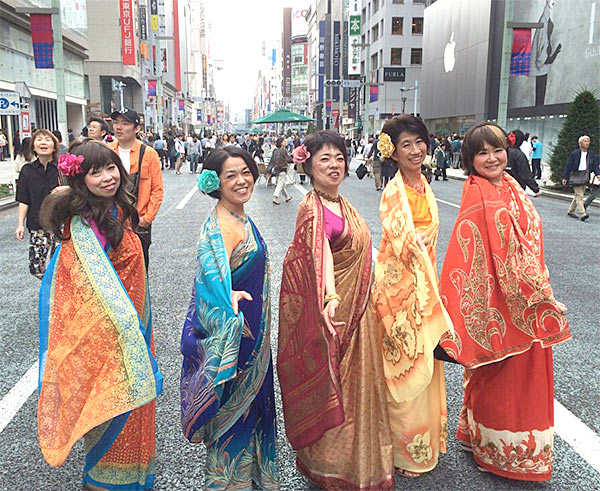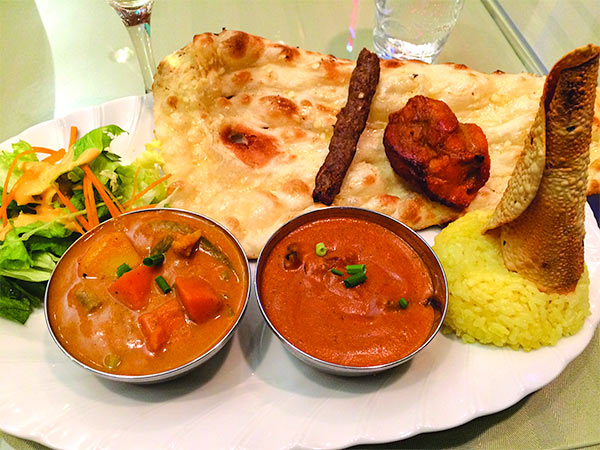'When I least expect it, I start to find traces of India in foreign lands,' says Aseem Chhabra.

The Sari Angels in Tokyo. Photograph: Aseem Chhabra
I have been visiting Japan for the past four years. And the more I walk on the streets of Tokyo, the more impressed I am by how well residents of the city dress. Young and old, even children and teenagers, have an amazing sense of fashion.
Last year I started a photo album on Facebook and titled it Faces of Tokyo. I have nearly 50 pictures in the album of random people I have stopped on the streets of Tokyo asking them if I can take their pictures. Most people are taken aback by the request, but then they stand and pose, sometimes giving wonderful smiles.
I was in the Ginza area with a couple of friends when I saw something amazing, even by Tokyo fashion standards. I saw two Japanese women walking in our direction wearing gaudy coloured saris.
And just when I was going to ask them for a picture, three more women arrived. Their saris were similar -- brightly coloured, kind of tacky, and made of some synthetic material. They each wore a matching blouse and a big flower on one side of their hair.
They stood in the middle of the street (the main streets in Ginza are closed to traffic on Sundays), holding their pallus on their left shoulders with smiles on their faces as if they were about to break into a Bollywood song.
One of the women -- Kimiko Haniwa -- told me she had picked up her sari in India. They call themselves the Sari Angels.
When I least expect it, I start to find traces of India in foreign lands.
Food mantra

The spread at Mantra. Photograph: Aseem Chhabra
Last week I spent three nights in Makuhari, a suburban town about 40 minutes away from Tokyo. While I like Japanese food and I love discovering new cuisines from the country, every few days the desi in me desires Indian food.
So on the second night in Makuhari (I had already been in Japan for four nights) I went to eat at what I believe was a new Indian eatery, Mantra.
As it turned out, Mantra is located in the same location where last year there was an Indian restaurant called Maharaja. I was told by a waiter that the restaurant is now owned by a Nepali man. The waiter was from Nepal although there was a server from Dehradun.
The food -- a prix fix (meal tha comes with fixed price) non-vegetarian platter looked nice in the presentation -- a large naan, a small seekh kebab, one piece of tandoori tikka, butter chicken, a mixed vegetable curry, and rice. But in taste it was just adequate.
The dishes had Indian flavours, but I could taste the separate masalas in the vegetable and chicken curries. Most annoying was the fact that the rice was not basmati. Rather, it was tasteless Japanese rice.
Oh well, at least the food appeared to be Indian.
An annual affair

Tokyo's Roppongi neighbourhood. Photograph: Tokyo Watcher/Wikimedia Commons
One of my favourite things to do in Tokyo is to visit the city's Roppongi neighbourhood. It is very popular with the expat population and locals. A happening place full of bars and restaurants. And films too have played a big part in Roppongi.
Quentin Tarantino was inspired to make a set of his film Kill Bill based on the interiors of a restaurant called Gonpanchi. The food there is decent and the restaurant is very popular with tourists.
And part of one of my all time favourite documentaries Jiro Dreams of Sushi is shot in Roppongi. The documentary is about a small sushi restaurant located in an underground passageway in the Ginza area. It is a three-Michelin star restaurant where reservations are made one month in advance and a 20-piece sushi meal costs $300 (Rs 18,000) per head.
A few years ago as I walked through Roppongi with a New Yorker friend, we stumbled on a quaint little Japanese restaurant also called Roppongi. Since then we have made an annual visit to the restaurant.
The food is simple, not very expensive, and presented in small plates. This time we had pieces of marinated beef, garlic rice, and mushrooms with breadcrumbs. One of the appetisers we ordered was sauted onions.
It was a beautiful presentation and along with the onions we were given small portions of two salts -- a white powdery one from Japan and a pink-coloured one with slightly bigger pieces, and a crunchy touch from Pakistan. The taste of the salts was similar, but the two varieties were so different in appearance.









